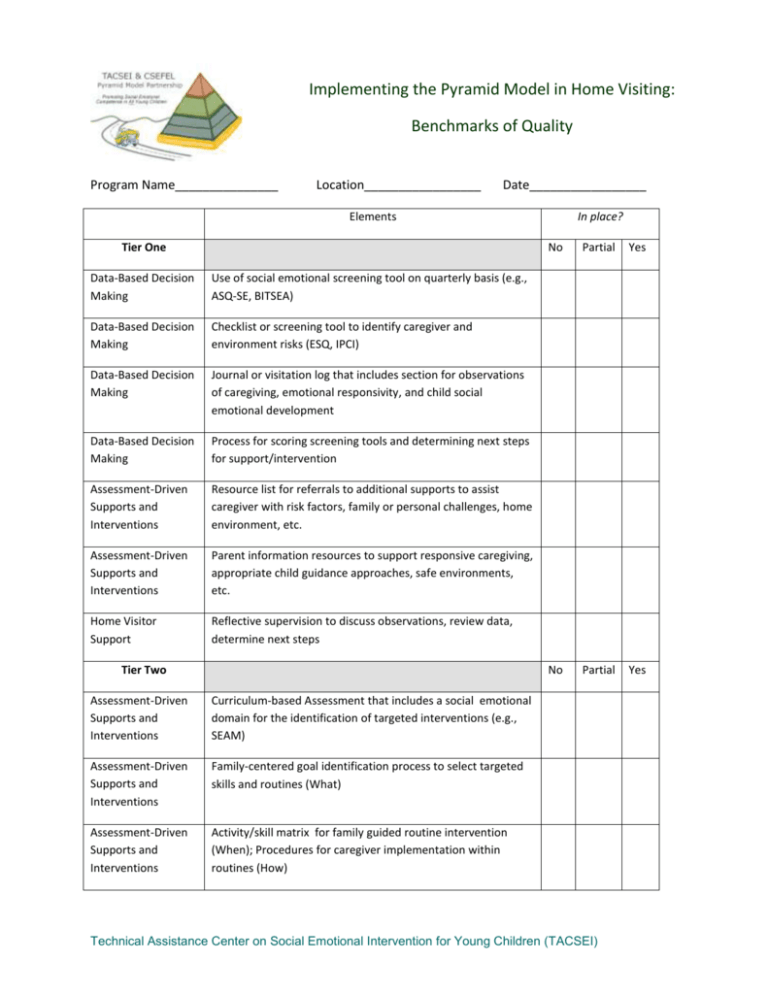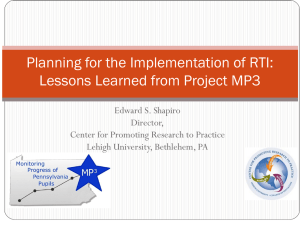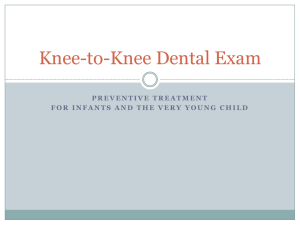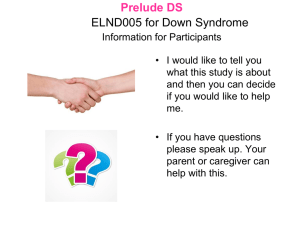Implementing the Pyramid Model in Home Visiting
advertisement

Implementing the Pyramid Model in Home Visiting: Benchmarks of Quality Program Name_______________ Location_________________ Date_________________ Elements Tier One Data-Based Decision Making Use of social emotional screening tool on quarterly basis (e.g., ASQ-SE, BITSEA) Data-Based Decision Making Checklist or screening tool to identify caregiver and environment risks (ESQ, IPCI) Data-Based Decision Making Journal or visitation log that includes section for observations of caregiving, emotional responsivity, and child social emotional development Data-Based Decision Making Process for scoring screening tools and determining next steps for support/intervention Assessment-Driven Supports and Interventions Resource list for referrals to additional supports to assist caregiver with risk factors, family or personal challenges, home environment, etc. Assessment-Driven Supports and Interventions Parent information resources to support responsive caregiving, appropriate child guidance approaches, safe environments, etc. Home Visitor Support Reflective supervision to discuss observations, review data, determine next steps Tier Two Assessment-Driven Supports and Interventions Curriculum-based Assessment that includes a social emotional domain for the identification of targeted interventions (e.g., SEAM) Assessment-Driven Supports and Interventions Family-centered goal identification process to select targeted skills and routines (What) Assessment-Driven Supports and Interventions Activity/skill matrix for family guided routine intervention (When); Procedures for caregiver implementation within routines (How) In place? No Partial Yes No Partial Yes Technical Assistance Center on Social Emotional Intervention for Young Children (TACSEI) Assessment-Driven Supports and Interventions Coaching process for caregiver implementation of interventions Data-Based Decision Making Checklist for observing caregiver implementation fidelity Data-Based Decision Making Data collection tool and form to monitor child/caregiver progress Data-Based Decision Making Behavior incident recording form for families to capture information on emerging concerns Data-Based Decision Making Home visitor protocol for inquiring about behavior challenges/emergent concerns and offering support Tier 3 No Data-Based Decision Making Functional assessment observation forms/procedures and interview Data-Based Decision Making Process for gaining team input and/or outside referrals Data-Based Decision Making Information gathered is synthesized into hypotheses; Hypotheses validated/reviewed by other team members Data-Based Decision Making Data collection system is established (by home visitor or family/caregiver) Assessment-Driven Supports and Interventions Hypothesis review and support plan development in partnership with the family Assessment-Driven Supports and Interventions Written plan is provided to the family/caregiver using familyfriendly language; Needed supports are provided to the family Assessment-Driven Supports and Interventions Coaching process for caregiver implementation of interventions Data-Based Decision Making Checklist for observing caregiver implementation fidelity Data-Based Decision Making Data are reviewed to monitor child/caregiver progress Partial Yes Please Note Elements listed should be a part of program practices for all home visitors Tiers are considered to be additive, for example Tier 1for supports, tools, and practices are still Technical Assistance Center on Social Emotional Intervention Young Children (TACSEI) needed when providing Tier 3 supports to a child/family








